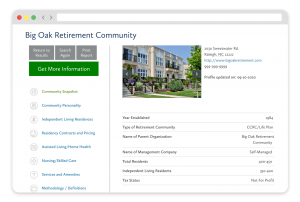The decision to downsize and transition into a senior living community is often filled with an array of emotions as well as some logistical complexity. Whether you’re an older adult looking to simplify your lifestyle, or an adult child helping a parent through this change, it’s important to understand what goes into the senior downsizing process and how to make it as smooth and empowering as possible.
Why downsize?
For many older adults, downsizing isn’t just about reducing square footage or getting rid of the unneeded “stuff” you’ve accumulated over the years. It’s about aligning your living environment with your current lifestyle, health needs (or potential needs that could develop down the road), and your future goals.
Many people choose to proactively downsize and move either to a smaller home or into an independent living or continuing care retirement community (CCRC, also called a life plan community). Such senior living communities enable residents to enjoy greater peace of mind and reduced home maintenance, plus increased access to social, recreational, and health-related resources and amenities.
But even when the benefits of downsizing seem clear, the path to actually getting there requires both careful thought and detailed preparation.
>> Related: Overcoming the Mental & Emotional Barriers of Downsizing
The emotional and practical sides of downsizing
For most people, our homes are more than just buildings; they contain decades of memories, milestones, and personal treasures. Sorting through a lifetime’s worth of belongings in one’s home can be emotionally overwhelming and mentally and physically exhausting. And it’s not just about the tangible items; it’s about the stories those items hold, and sometimes, the people they represent.
From a practical standpoint, downsizing requires several key steps. It begins with choosing a new home and then determining what will fit comfortably into that new space … and what won’t. This requires the often-difficult task of prioritizing essentials, such as daily-use furniture, clothing, and any medical equipment, while letting go of items that no longer serve a practical purpose. Older adults and their families must make thoughtful decisions about what to keep, gift, sell, donate, or discard.
At the same time, the logistics of moving come into play: packing, coordinating movers, and setting up the new home. When combined with the emotional strain, these tasks can feel daunting, especially for older adults who may be navigating health challenges, or for adult children balancing caregiving responsibilities with their own busy lives.
That’s why taking the time to approach the process with care, and seeking help when needed, can make all the difference.
>> Related: Grappling With The Finality of “The Last Move” to a Retirement Community
The value of senior living relocation services
To help address the many moving parts of a move, senior relocation specialists can be an extremely helpful resource. These professionals provide hands-on support and project management during every phase of the downsizing and moving process. They’re not just movers; they’re trusted guides trained to work with older adults and their families with compassion, efficiency, and respect.
Senior relocation specialists can help with tasks like:
- Customized planning: They assess the older adult’s needs, new space, and timeline to create a detailed move plan.
- Sorting and decision support: They help categorize items for keeping, gifting, selling, donating, or discarding, without judgment or pressure.
- Professional packing and moving coordination: Everything from hiring and overseeing movers to unpacking and setting up the new home can be handled by them.
- Estate cleanout and home prep: If the previous home will be sold, they can help clear it out, clean it, and ready it for real estate professionals.
These specialized providers often work in partnership with senior living communities’ move-in coordinators and can dramatically reduce the physical and emotional strain of a major move.
One example of a senior living relocation service is Liv Now, cofounded by Maureen Longoria, which helps older adults and their families manage the emotional and logistical challenges of downsizing and moving. Liv Now connects clients with vetted senior move managers who assist with sorting, selling, donating, or preserving belongings, while also coordinating vetted providers for estate sales, real estate services, movers, and other necessary tasks.
From digitizing old photos to comparing cost estimates, the process is designed to preserve memories and reduce anxiety for the older adult and their loved ones. As Maureen puts it, “Having a relocation service takes the stress and emotion out of the senior living transition process. It gives families peace of mind knowing there’s a plan and that they don’t have to do it alone.”
Maureen continues: “We also encourage our clients to tell the stories behind the ‘stuff,’ and then let family members decide what they want and what they don’t want. This sharing process can make it easier to let the ‘stuff’ go.”
>> Related: Resources to Reduce the Stress of Moving to a CCRC
Why documenting belongings matters
Along this same vein, an often-overlooked but critical part of the downsizing process is documenting personal belongings, especially when multiple family members are involved. Whether using simple spreadsheets, labeled photographs, or inventory apps, documenting household contents serves several important purposes:
- Clarity and transparency: Everyone involved knows what’s being moved, sold, donated, or kept.
- Easier decision-making: Visual documentation helps older adults and family members evaluate what’s truly needed or meaningful.
- Legal and insurance protection: A documented inventory is essential for any claims related to loss, damage, or estate planning.
- Legacy and memory preservation: Some items have sentimental value or family history worth recording, even if they’re not being kept.
One example of a tool that can be helpful to this documentation process is the Valuable app, created by Bill Goodwin. The app supports older adults and their families during the downsizing and relocation process by simplifying inventory, valuation, and storytelling.
Originally built for personal collections, Valuable now includes enterprise features that help senior relocation specialists, senior move managers, estate sale organizers, and older adults/families efficiently catalog items, group them by category, and identify what’s worth selling, keeping, or donating. The app’s AI even recommends the best resale venues and can be trained for specialized details like wood types or place and time period of origin.
The latest version of the Valuable app can be especially useful for senior move managers, allowing them to create groups for clients and subgroups for different item categories. “This feature simplifies the logistics coordination process and eliminates the need for less efficient organization methods like notepads or spreadsheets,” explains Bill.
For family members, Valuable facilitates the equitable division and transfer of possessions, enabling users to easily track items’ locations. But perhaps just as important, Valuable also preserves family history, allowing users to record and share audio stories connected to heirlooms and sentimental pieces with future generations.
>> Related: Why Do Many Retirement Community Residents Say, ‘I Wish I’d Moved Sooner’?
Downsizing and senior living transition checklist
Still feeling overwhelmed by the idea of downsizing and making a senior living transition? Here’s a practical checklist to guide you or your loved one through the process of downsizing and making a senior living move.
PLANNING STAGE
____Talk openly among family about the move.
____Schedule tours of senior living communities and ask questions.
____Choose the right senior living community to fit your goals and budget.
____Get floor plans and room dimensions for space planning.
____Hire a senior move manager or relocation service (optional but highly recommended).
SORTING & DECISION-MAKING
____Walk room-by-room in your home and list must-keep items.
____Begin sorting items into categories: Keep, Donate, Sell, Gift, Recycle/Discard.
____Photograph or list sentimental items for documentation.
____Identify items to be distributed to loved ones, either now or later.
____Create a digital or printed inventory list.
MOVING PREP
____Obtain packing supplies or hire professional packers and movers.
____Arrange donation pick-ups or estate sale help.
____Schedule utilities to be canceled or transferred.
____Notify post office, doctors, banks, and others of address change.
____Label boxes by room and contents.
MOVING DAY
____Have essentials packed separately (medications, important papers, clothing, toiletries, cleaning supplies, etc.).
____Be present or have a trusted family member/friend on-site for the movers.
____Use your inventory list to check off items as they are moved.
____Conduct a final walkthrough of the old home.
SETTLING IN
____Unpack and arrange essential items first.
____Help your loved one get acquainted with the new space and community.
____Hang familiar art, display keepsakes, and make the space feel like home.
____Schedule a visit from friends or family in the first week to ease the transition.
____Continue updating documentation for any future moves or estate planning.
A new beginning, not just a move
While downsizing and moving to a smaller home or a retirement community can feel like a daunting task, it’s also an opportunity to refocus on what matters most: your comfort, safety, relationships, and personal wellbeing.
With the right planning, support, and mindset, transitioning into senior living doesn’t have to be a tremendous burden. It can be a meaningful, empowering journey, one made easier with the help of compassionate professionals, clear communication, and thoughtful documentation.
Whether you’re the one making the move or helping a loved one take this important step, remember: You’re not alone, expert assistance is available, and this can be the start of a wonderful new chapter in a person’s life!

FREE Detailed Profile Reports on CCRCs/Life Plan Communities
Search Communities






